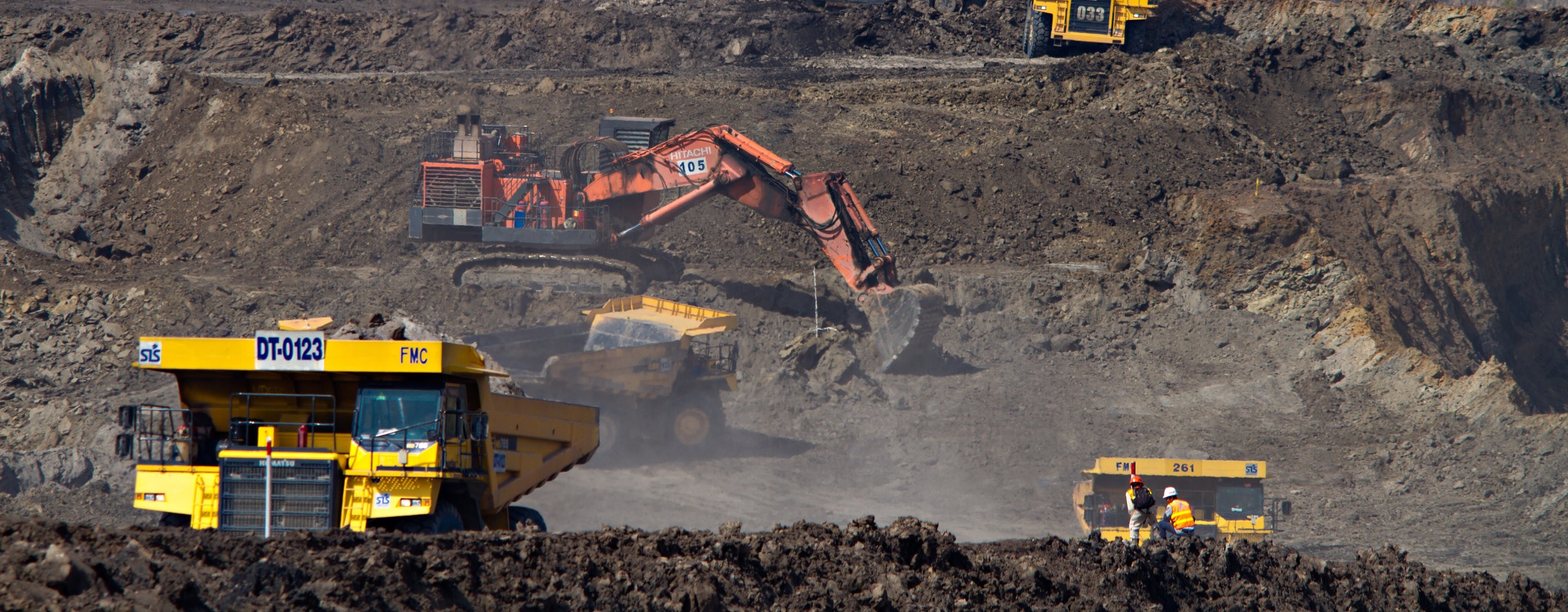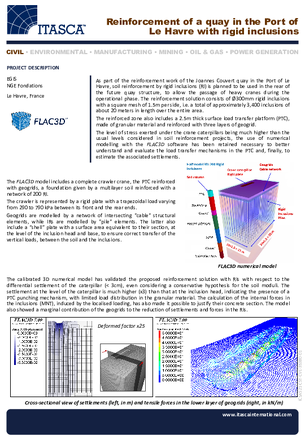
Reinforcement of a quay in the Port of Le Havre with rigid inclusions (2023)
As part of the reinforcement work of the Joannes Couvert quay in the Port of Le Havre, soil reinforcement by rigid inclusions (RI) is planned to be used in the rear of the future quay structure, to allow the passage of heavy cranes during the operational phase.
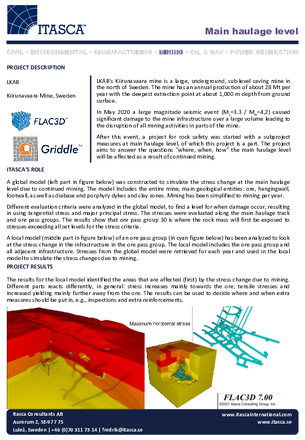
Main Haulage Level (2022)
Following a large seismic event, a project for enhancing mine safety at the LKAB Kiirunavaara Mine was initated. One subproject deals with the stability of the main haulage level and associated critical infrastructure, which were analyzed using a combined mine-scale/local-scale modeling approach.
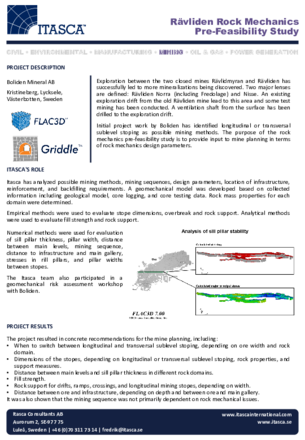
Rävliden Rock Mechanics Pre-Feasibility Study (2021)
Exploration between the two closed mines Rävlidmyran and Rävliden has
successfully led to more mineralizations being discovered. Itasca has analyzed possible mining methods, mining sequences, design parameters, location of infrastructure, reinforcement, and backfilling requirements.

Effective elastic properties of fractured rocks (2021)
The objective of the project is to predict the scaling evolution of rock mass effective elastic properties for conditions relevant to the POSE (Posiva’s Olkiluoto Spalling Experiment) niche surroundings at ONKALO, the Finnish site for underground storage of nuclear waste.
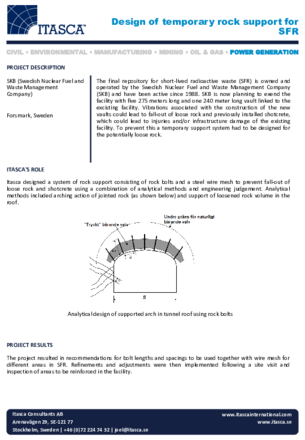
Design of temporary rock support for SFR (2021)
The Swedish Nuclear Fuel and Waste Management Company (SKB) is planning to extend the short-lived radioactive waste repository with five 275 meters long and one 240 meter long vault. Since the extension could lead to damage on the existing facility, Itasca designed a temporary support system to prevent loose rock.

Modeling of Spalling in PFC3D — A Quantitative Assessment (2020)
SKB is interested in developing a 3D discrete model to predict spalling on the excavation boundaries of underground repositories for the long-term storage of spent nuclear fuel. This project provided a quantitative assessment of modeling spalling using PFC3D to study both lab- and tunnel-scale behavior.

Simulating Spalling With a Flat-Jointed Material (2020)
Long-term storage of spent fuel is critical to the nuclear energy industry. The Swedish Nuclear Fuel and Waste Management Company (SKB) is developing an approach for the storage of spent nuclear fuel in an underground repository in competent crystalline rock. In order to better understand the spalling damage process, an in-situ test involving the drilling of two boreholes was performed in Äspö diorite at SKB’s underground hard rock laboratory in Äspö. Tests and monitoring were performed on the pillar that separated the boreholes. In order to further investigate the damage process, Itasca performed numerical modeling using PFC3D and FLAC3D.

Rock mechanical analyses for the Boliden deep repository at Rönnskär (2020)
Boliden AB is constructing an underground repository for final storage of process waste material from the Rönnskär copper smelter facility. The repository is excavated at a depth of 330 m and the main components are storage rooms with a vertical footprint of 16 by 18 m and with lengths varying between 50 and about 200 m. Itasca was contracted by Boliden to carry out rock mechanical analysis to assess the stability in both the short- and long-term (3000 years) perspectives. FLAC3D and 3DEC models were used to study global and local stability as well as the potential for long term effects on flow paths in the rock mass resulting from the excavation of the repository.

Seismic Performance of the OPC Puerto Cortes Container Terminal in Honduras (2019)
Itasca conducted a seismic performance evaluation of the trestle‐wharf section of the OPC Puerto Cortes Container Terminal, located in Honduras. A FLAC3D analysis of the soil is performed, including the piles and deck of the terminal. This is a fullycoupled, dynamic, soil‐structure, time‐history analysis that quantifies the performance and potential risks for the structure and slope. The Finn model – Byrne formulation was utilized using data from investigation boreholes.

Penetration of a Single Steel Foundation Pin in a Granitic Rock (2018)
The development of a subsea tidal turbine requires specific research work concerning the design of the foundation in contact with the seabed. This design stage can be simplified by the use of numerical modelling and more particularly by using discrete modelling. HydroQuest asked Cathie Associates to check their previous calculations regarding the behavior of a single steel foundation pin in a granitic rock mass by using Itasca’s discrete numerical approach and follow the forces applied to the pin as well as the state of the damaged zone around the tip during penetration.

Modelling over-boring and extension of a tunnel with surrounding excavations (2018)
As part of phase four in the extension of the ANDRA Meuse/Haute-Marne Underground Research Laboratory, a safety niche (called GT1) will be over-bored into a larger section, then extended. The tunnel axis is 16 m from an auxiliary shaft (named PX). Two perpendicular drifts, called GLN and GLE, connect these 2 excavations.

Junction Dam (2018)
Built between 1959 and 1961, Junction Dam is a double-curvature concrete arch dam located on Silver Creek in El Dorado County, California, just downstream from where Little Silver Creek and South Fork Silver Creek merge. The dam is in a relatively narrow canyon with steep sides and retains the Junction Reservoir.

Mechanical testing of a model baked anode material with PFC (2017)
A baked anode is a complex material, that results from the mixing and baking of different petrol coke grains, with different size distributions, with a pitch. A preliminary study (ICSAS16-CST-MFG-35143-01) developed a PFC2D model accounting for the microstructure of a baked anode, using the Bonded Particle Model (BPM).

Dynamic Soil Structure Interaction Analyses of North Shore Pump Station (2017)
Located near Fisherman’s Wharf in San Francisco, North Shore Pump Station is a part of the North Point Wet-Weather Facility (NPF), which provides primary treatment for disinfection of wastewater. The facility is a two-story building that is completely embedded in soil, and the subsurface conditions include potentially liquefiable sand layers and soft Bay Mud deposits sitting on bedrock sloping toward the east side waterfront. The building is supported by piers extending all the way into the Franciscan Complex bedrock.

Karowe Mine Groundwater Flow Model and Predictive Dewatering Simulations (2017)
Karowe Mine, located approximately 16 kilometers (km) southwest of the town of Letlhakane, is a diamond mine where the second largest diamond ever found on record, with a weight of 1,111 carats, was discovered. This project involved simulating mine dewatering and excavation to evaluate future dewatering requirements, as well as providing guidance for future monitoring borehole and piezometer designs.
